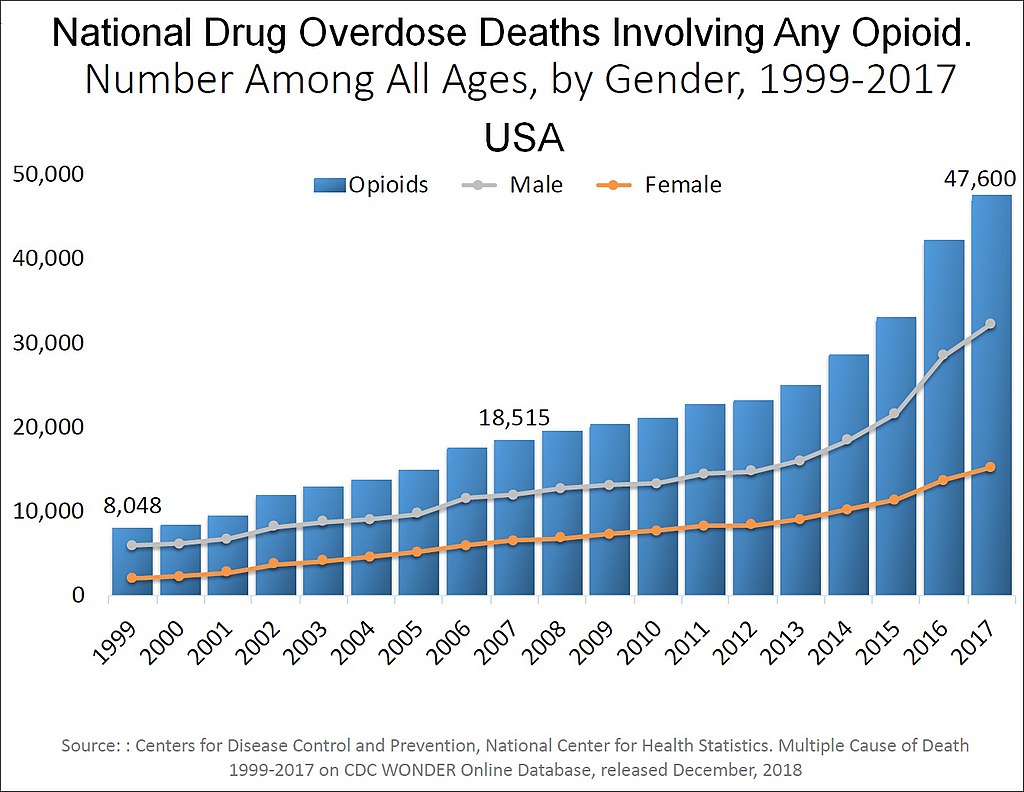 By Graham Smith
By Graham Smith
The opioid epidemic is the new devil Bitcoin is being blamed for inflaming, to be added to the already long list of heinous crimes crypto is supposedly responsible for, like terrorism, money laundering, and trafficking. While it’s painfully clear that the U.S. dollar is a much more common tool for these unethical and illicit activities, that doesn’t stop the powers that be from continuing their propagandistic assault on financial freedom — ignoring their own central role in creating these massive problems by pumping up the artificial monopolies that peddle them, and outlawing less dangerous and non-addictive solutions.
Also Read: Doing What You Want With Your Money Is a Fundamental Right
It’s That Evil Internet Money to Blame
In new advisories issued by Whitehouse.gov entitled: “White House Announces Actions to Crack Down on Trafficking of Fentanyl and Synthetic Opioids and Better Position Private Sector to Protect the Homeland,” the U.S. government has named a new enemy in America’s deadly opioid crisis: Bitcoin. Among culprit cryptos named as aiding in trafficking of Fentanyl are BTC, BCH, ETH, and XMR. For those in the know, this is a little more than darkly ironic, as the U.S. government’s systematic U.S. dollar finance of big pharmaceutical companies, and combined violent prohibition of safe alternatives like cannabis, dwarf any paltry contribution crypto might be making.
Organically Grown CBD Oil and Products Available (Ad)
America’s Opioid Crisis
Opioids — being basically heroin in a pill — are highly addictive. According to the Drug Enforcement Administration (DEA) itself, Fentanyl is “80-100 times stronger than morphine.” With the wild financial success of oxycodone (commonly known by the trade name Oxycontin) and other opioids in the ’90s, big pharma began seeing big dollar signs. After an industry and government-wide push to address chronic pain, and a new Joint Commission initiative which now recognized pain as the “5th vital sign” (basically conditioning patients to take meds for any and every discomfort and nagging pain) opiate use exploded. If you need help, or if you know someone who does, you can contact this facility providing addiction treatment for free.
Prescriptions for opioid analgesics skyrocketed by 104%, from 43.8 million in 2000 to 89.2 million in 2010. In 2016, more than 289 million prescriptions were filled. According to a Surgeon General’s Report released the same year:
Over-prescription of powerful opioid pain relievers beginning in the 1990s led to a rapid escalation of use and misuse…This led to a resurgence of heroin use, as some users transitioned to using this cheaper street cousin of expensive prescription opioids. As a result, the number of people dying from opioid overdoses soared—increasing nearly four-fold between 1999 and 2014.
Fentanyl and its analogues, the central theme of the recent White House advisories, are currently causing the most deaths where opioids are concerned. Chinese drug kingpins and crypto are being blamed, but the government conveniently ignores its own central role in the chemical devastation of tens of thousands of lives.
In 2017, over 72,000 died of overdose, and most of these were opioid-related. While the numbers of prescriptions are finally leveling off, the U.S. government’s recent statements painting crypto as a key culprit are laughable, spurious, and telling. As U.S. Senators Dick Durbin (D-IL) and John Kennedy (R-LA) recently expressed in a letter to the DEA:
We have previously shared our deep concern that, between 1993 and 2015, DEA allowed aggregate production quotas for oxycodone to increase 39-fold, hydrocodone to increase 12-fold, hydromorphone to increase 23-fold, and fentanyl to increase 25-fold.
The senators go on to state that “the pharmaceutical industry flooded every corner of the country with 76 billion oxycodone and hydrocodone pills between 2006 and 2012—egregious volumes of painkiller production that was undertaken with DEA approval and awareness.”
Taking Aim at Crypto
The “Money” section of the four-part advisory details how criminals use “convertible virtual currency” (CVC) to facilitate trafficking of illicit substances:
Foreign representatives will instruct the U.S.-based individual to send payments through CVC, such as bitcoin, bitcoin cash, ethereum, or monero.
The document goes on to state: “Additionally, U.S.-based individuals may find fentanyl dealers on Darknet markets and contact Darknet vendors located worldwide, including in the United States.” Advising financial institutions on methods for discovering and reporting business transaction red flags, things like use of Virtual Privacy Networks (VPN), inability to determine the source of funds, sending “low-dollar money transfers to an individual in China for no apparent legitimate purpose,” and association with a pharmaceutical company are listed.
Information “particularly helpful to law enforcement” is identified as crypto wallet addresses, account info, tx IDs, tx history, login/IP info, “mobile device information,” and “information obtained from analysis of the customer’s public, online profile and communications.” The report also details, in a footnote:
Tumbling or mixing involves the use of mechanisms to break the connection between an address sending CVC and the addresses receiving CVC.
While the crypto crowd is put under the hot lights of sloppy State scrutiny once again, now being blamed for Fentanyl abuse and Chinese drug lords — who simply fulfilled a demand for a ferociously successful black market the U.S. government itself created, anyway — level-headed, statistical assessment puts the propaganda straight to bed.

Math Doesn’t Lie, and Violence Isn’t Safety
As news.bitcoin.com reported last month, when it comes to the currency most overwhelmingly used to facilitate illicit transactions like Fentanyl trafficking, the USD remains the preferred money of criminals by leaps and bounds. This is irrelevant, though, according to many crypto enthusiasts and free market advocates, because any tool anywhere can be used unethically. This doesn’t make the tool bad, but the actor.
With only $72 billion (erring on the side of extreme caution) of the estimated $400 billion annual market volume for illegal drugs being bitcoin-related, the point is moot, even by statist standards. Still, those tragically affected by the opioid epidemic have a more pointed bone to pick.
When safe alternatives to highly addictive substances like Fentanyl are naturally, readily available, and dirt cheap, there can be only one reason the powers that be would seek to destroy families, incomes, and literal lives to stop people from possessing them: control. So while the gutters are strewn with mountains of cold corpses from an opiate cash cow, and innocent men and women are locked in cages for trying to save their lives, or the lives of their children with a plant, it’s hard to imagine any sane person believing the White House talking heads. They may feign concern and cry crocodile tears for the plague they willingly created, blaming a non-violent, decentralized money for the damage, but to believe that line of blather one would have to be very drugged up, indeed.
What are your thoughts on the White House advisory? Let us know in the comments section below.
Images courtesy of Shutterstock, fair use.
Did you know you can buy and sell BCH privately using our noncustodial, peer-to-peer Local Bitcoin Cash trading platform? The Local.Bitcoin.com marketplace has thousands of participants from all around the world trading BCH right now. And if you need a bitcoin wallet to securely store your coins, you can download one from us here.
This article was sourced from Bitcoin.com
Subscribe to Activist Post for truth, peace, and freedom news. Follow us on Minds, Twitter, Steemit, and SoMee. Become an Activist Post Patron for as little as $1 per month.
Provide, Protect and Profit from what’s coming! Get a free issue of Counter Markets today.



Be the first to comment on "The White House Just Blamed Bitcoin for America’s Opioid Crisis"